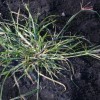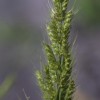 Sorghum-almum is a weak, perennial rhizomatous grass. Leaves of seedlings are rolled in a bud with a fringed membranous ligule. Seedlings often resemble corn seedlings when small. Stems of mature plants are stout and erect, reaching up to 14 feet tall. Leaf blades are flat and sandpapery. Sorghum-almum is commonly found in the southern part of Florida in sugarcane fields and along ditches, canals, and roadsides. This 3-page fact sheet was written by Dennis Calvin Odero, Ron Rice, and Les Baucum , and published by the UF Department of Agronomy, January 2013.
Sorghum-almum is a weak, perennial rhizomatous grass. Leaves of seedlings are rolled in a bud with a fringed membranous ligule. Seedlings often resemble corn seedlings when small. Stems of mature plants are stout and erect, reaching up to 14 feet tall. Leaf blades are flat and sandpapery. Sorghum-almum is commonly found in the southern part of Florida in sugarcane fields and along ditches, canals, and roadsides. This 3-page fact sheet was written by Dennis Calvin Odero, Ron Rice, and Les Baucum , and published by the UF Department of Agronomy, January 2013.
http://edis.ifas.ufl.edu/sc098
Tag: Leslie E. Baucum
Biology and Control of Horse Purslane and Common Purslane in Sugarcane (SSAGR368/SC097)
 Horse purslane and common purslane are broadleaf weeds associated with sugarcane fields in muck (organic) and mineral soils of South Florida. Growers often confuse these two weed species with each other. However, these two species have distinct phylogenetic (evolutionary) and morphological differences. This 4-page fact sheet was written by Dennis Calvin Odero, Ron Rice, and Les Baucum, and published by the UF Department of Agronomy, January 2013.
Horse purslane and common purslane are broadleaf weeds associated with sugarcane fields in muck (organic) and mineral soils of South Florida. Growers often confuse these two weed species with each other. However, these two species have distinct phylogenetic (evolutionary) and morphological differences. This 4-page fact sheet was written by Dennis Calvin Odero, Ron Rice, and Les Baucum, and published by the UF Department of Agronomy, January 2013.
http://edis.ifas.ufl.edu/sc097
Biology and Control of Goosegrass in Sugarcane (SSAGR367/SC096)
 Goosegrass is an annual plant that produces a prostrate, mat-like rosette with flattened stems radiating from a central point. It is often described as looking like someone has stepped in the middle of the plant, flattening it out. Because of the whitish to translucent color of the leaf sheath margins, goosegrass usually appears white to silver; this is why it is known as white or silver crabgrass. Goosegrass is found year-round in southern Florida and is commonly associated with newly planted and stubble (ratoon) sugarcane fields. This 3-page fact sheet was written by Dennis Calvin Odero, Ron Rice, and Les Baucum, and published by the UF Department of Agronomy, January 2013.
Goosegrass is an annual plant that produces a prostrate, mat-like rosette with flattened stems radiating from a central point. It is often described as looking like someone has stepped in the middle of the plant, flattening it out. Because of the whitish to translucent color of the leaf sheath margins, goosegrass usually appears white to silver; this is why it is known as white or silver crabgrass. Goosegrass is found year-round in southern Florida and is commonly associated with newly planted and stubble (ratoon) sugarcane fields. This 3-page fact sheet was written by Dennis Calvin Odero, Ron Rice, and Les Baucum, and published by the UF Department of Agronomy, January 2013.
http://edis.ifas.ufl.edu/sc096
Biology and Control of Coast Cockspur in Sugarcane (SSAGR366/SC095)
 Coast cockspur is a relative of barnyardgrass that is native to North America. In South Florida, coast cockspur typically begins to infest sugarcane during the onset of rainfall in late spring. This 2-page fact sheet was written by Dennis Calvin Odero, Ron Rice, and Les Baucum, and published by the UF Department of Agronomy, January 2013.
Coast cockspur is a relative of barnyardgrass that is native to North America. In South Florida, coast cockspur typically begins to infest sugarcane during the onset of rainfall in late spring. This 2-page fact sheet was written by Dennis Calvin Odero, Ron Rice, and Les Baucum, and published by the UF Department of Agronomy, January 2013.
http://edis.ifas.ufl.edu/sc095
Lesser Cornstalk Borer Damage to Sugarcane and the Effects of Tillage and Harvest Residue Management (ENY454/SC094)
 This 6-page fact sheet provides an overview of this pest, its damage to sugarcane, and the plant’s response, and describes the results of a study of harvest residue and controlled tillage experiments. Written by Hardev S. Sandhu, Leslie E. Baucum, and Gregg S. Nuessly, and published by the UF Department of Entomology and Nematology, May 2012.
This 6-page fact sheet provides an overview of this pest, its damage to sugarcane, and the plant’s response, and describes the results of a study of harvest residue and controlled tillage experiments. Written by Hardev S. Sandhu, Leslie E. Baucum, and Gregg S. Nuessly, and published by the UF Department of Entomology and Nematology, May 2012.
http://edis.ifas.ufl.edu/sc094
Calcium Silicate Recommendations for Sugarcane on Florida Organic Soils (SSAGR350/SC092)
 Although silicon isn’t an essential plant nutrient, adding calcium silicate to soils low in soluble silicon increases yield an average of 20%. This 5-page fact sheet describes calcium silicate recommendations for sugarcane on organic soils, developed using field studies at several locations. Written by J. Mabry McCray, Ronald W. Rice, and Leslie E. Baucum, and published by the UF Department of Agronomy, August 2011. (UF/IFAS Photo: Josh Wickham)
Although silicon isn’t an essential plant nutrient, adding calcium silicate to soils low in soluble silicon increases yield an average of 20%. This 5-page fact sheet describes calcium silicate recommendations for sugarcane on organic soils, developed using field studies at several locations. Written by J. Mabry McCray, Ronald W. Rice, and Leslie E. Baucum, and published by the UF Department of Agronomy, August 2011. (UF/IFAS Photo: Josh Wickham)
http://edis.ifas.ufl.edu/sc092
Life Cycle of the Lesser Cornstalk Borer in Sugarcane (ENY913/SC093)
 The lesser cornstalk borer attacks a large number of crops, but is a potentially serious pest of sugarcane. But since the populations of this pest vary greatly depending on temperature, UF/IFAS scientists are developing predictive models to predict lesser cornstalk borer population in field. This 4-page fact sheet was written by H.S. Sandhu, L.E. Baucum, and G.S. Nuessly and published by the UF Department of Entomology and Nematology, September 2011.
The lesser cornstalk borer attacks a large number of crops, but is a potentially serious pest of sugarcane. But since the populations of this pest vary greatly depending on temperature, UF/IFAS scientists are developing predictive models to predict lesser cornstalk borer population in field. This 4-page fact sheet was written by H.S. Sandhu, L.E. Baucum, and G.S. Nuessly and published by the UF Department of Entomology and Nematology, September 2011.
http://edis.ifas.ufl.edu/sc093
SC088 Costs and Returns for Sugarcane Production on Muck Soils in Southern Florida 2008 – 2009
SC088, a 14-page report by Fritz M. Roka, Leslie E. Baucum, and José Alvarez, estimates an enterprise budget that reflects annual costs and returns for a 5,000-acre farm that grows sugarcane on organic soil, commonly referred to as “muck.” Includes references. Published by the UF Department of Food and Resource Economics, March 2010.
http://edis.ifas.ufl.edu/sc088